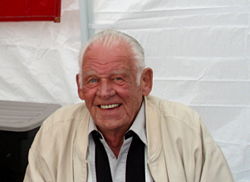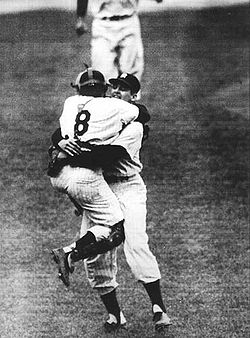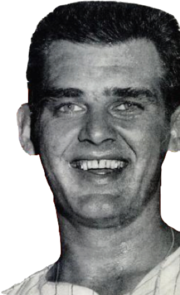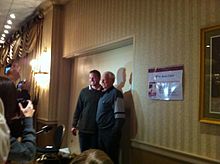- Don Larsen
-
Don Larsen 
Larsen at a Yankees fan fair in 2007Pitcher Born: August 7, 1929
Michigan City, IndianaBatted: Right Threw: Right MLB debut April 18, 1953 for the St. Louis Browns Last MLB appearance July 7, 1967 for the Chicago Cubs Career statistics Win–Loss record 81–91 Earned run average 3.78 Strikeouts 849 Teams - St. Louis Browns / Baltimore Orioles (1953–1954)
- New York Yankees (1955–1959)
- Kansas City Athletics (1960–1961)
- Chicago White Sox (1961)
- San Francisco Giants (1962–1964)
- Houston Colt .45's / Houston Astros (1964–1965)
- Baltimore Orioles (1965)
- Chicago Cubs (1967)
Career highlights and awards - 2× World Series champion (1956, 1958)
- 1956 World Series MVP
- 1956 Babe Ruth Award
- Pitched a perfect game on October 8, 1956 in game five of the 1956 World Series against the Brooklyn Dodgers
Donald James Larsen (born August 7, 1929 in Michigan City, Indiana) is a former Major League Baseball pitcher. During a 15-year baseball career, he pitched from 1953-67 for seven different teams. Larsen is best known for pitching the sixth perfect game in baseball history, doing so in game 5 of the 1956 World Series. It is the only perfect game in MLB postseason and World Series history and is one of only two no hitters in MLB postseason history.
Contents
Baseball career
Early career
Larsen's career win-loss record was 81–91, as a journeyman pitcher for seven different franchises from 1953–1967. He had only two 10-win seasons, in 1956 and 1957. In 1954, Larsen went 3–21 with the Baltimore Orioles.
Larsen was traded by the Baltimore Orioles in part of a 17-player trade following the 1954 season, with Billy Hunter, Bob Turley and players to be named later to the New York Yankees for Harry Byrd, Jim McDonald, Willy Miranda, Hal Smith, Gus Triandos, Gene Woodling and players to be named later. Two weeks later, the Yankees sent Bill Miller, Kal Segrist, Don Leppert and Ted Del Guercio to the Orioles and the Orioles sent Mike Blyzka, Darrell Johnson, Jim Fridley and Dick Kryhoski to the Yankees to complete the trade.
As a member of the New York Yankees from 1955 through 1959, Larsen was used by manager Casey Stengel as a backup starter and occasional reliever. He went 45–24 during his five seasons in New York, making 90 starts in 128 appearances. His 1956 season was the best of Larsen's career; adopting a no-windup delivery late in the season,[citation needed] he posted an 11–5 record, with a career best 107 strikeouts and a 3.26 ERA.
Larsen also had a reputation as a partier. Stengel once said of Larsen, "The only thing he fears is sleep." When Larsen crashed his car into a light pole in the middle of the night during spring training, after curfew, Stengel quipped, "He must have gone out to mail a letter." Larsen's teammates gave the gangly right-hander the nickname "Gooney Bird."[citation needed]
The perfect game
 The "everlasting image" of Yogi Berra leaping into Larsen's arms upon the completion of the perfect game
The "everlasting image" of Yogi Berra leaping into Larsen's arms upon the completion of the perfect game
Larsen's most notable accomplishment was pitching the only perfect game in the history of the World Series; it is one of only 20 perfect games in MLB history. He was pitching for the New York Yankees in Game 5 of the 1956 World Series against the Brooklyn Dodgers on October 8, 1956. His perfect game remained the only no-hitter of any type ever pitched in postseason play until Philadelphia Phillies pitcher Roy Halladay threw a no-hitter against the Cincinnati Reds on October 6, 2010, in Game 1 of the National League Division Series.[1]
Larsen's opponent in the game was Brooklyn's Sal Maglie. The Larsen start was a slight surprise considering his performance in Game 2 of the Series. Despite being given a 6–0 lead by the Yankee batters, Larsen had lasted less than two innings, allowing four runs on four walks (combined with a crucial error by first-baseman Joe Collins). Larsen maintains that he did not even know he was going to start the fifth game of the World Series until he arrived at Yankee Stadium that morning and discovered a baseball tucked inside his baseball spikes, although newspapers across the country had him listed as the starter that day. Fifty years later, teammate Moose Skowron recalled, "I couldn't believe he was pitching that day. I still can't believe the look he had on his face when he saw the ball...shock or something." Backup catcher Charlie Silvera, who warmed up Larsen in the bullpen "very casually," remembered, "It wasn't like I went to anybody and said, 'He really has it, we're in'."
Larsen's control in this game did not desert him. He needed just 97 pitches to complete the game, and only one Dodger batter, (Pee Wee Reese in the first inning), was able to get a 3-ball count. In 1998, Larsen recalled, "I had great control. I never had that kind of control in my life." Larsen's catcher Yogi Berra said, "His stuff was good, good, good. Anything I put down, he put over."
There were a few close calls. The first was a "bang-bang" play in the second inning, when Dodger second baseman Jackie Robinson hit a line drive that caromed off Yankee third baseman Andy Carey's glove. Fortunately for Larsen, it bounced straight to shortstop Gil McDougald, who threw out Robinson in a close play. In the fifth inning, center fielder Mickey Mantle made a back-handed catch in left-center field, running down a deep drive by Gil Hodges. The next batter, Sandy Amoros, hit a long drive to right field that went just foul; when asked about how close it was, umpire Ed Runge held his thumb and index finger an inch apart and said, "That much."
Brooklyn's Maglie also pitched an outstanding game, giving up only two runs on five hits. Mickey Mantle's fourth-inning home run broke the scoreless tie. The Yankees added an insurance run in the sixth.
The later innings were tense for players and fans alike. Larsen's teammates remained silent. Baseball custom dictates that players never discuss the possibility of a no-hitter as it unfolds. Both TV announcers — Hall of Fame broadcasters Mel Allen, who did the first half of the game, and Vin Scully, who did the second half of the game—adhered to the baseball custom of never using the words "no-hitter" or "perfect game" on the air; instead, Scully, in the later innings, made repeated reference to the number of Dodgers retired consecutively, and, at the beginning of the ninth inning, stated that "Yankee Stadium is shivering to its concrete foundations."
This traditional taboo against talking about a no-hitter meant little to Larsen, who playfully asked his teammates if they thought he could complete it, earning a gruff dismissal from Mantle. Larsen says that Mantle stalked away in silence; some teammates remember Mantle saying, "Shut the fuck up." The unconcerned Larsen even took a cigarette break in the clubhouse during the seventh inning stretch. "I had no tension on the mound," remembered Larsen, "but the dugout was a morgue. No one would talk to me. I was more comfortable on the mound than there."
With the score still at 2–0, manager Casey Stengel had Whitey Ford warming up in the bullpen during the eighth and ninth innings, in case Larsen got into trouble. After Larsen got Carl Furillo to fly out for the first out of the ninth, Ford and Silvera stopped warming up and watched the conclusion of the game.
With two outs in the ninth inning, Larsen faced pinch hitter Dale Mitchell, a .311 career hitter. Throwing fastballs, Larsen got ahead in the count at 1–2. On his 97th pitch, a called strike, Larsen caught Mitchell looking for the 27th and last out. Mitchell complained that the pitch was high and outside to home plate umpire Babe Pinelli (who was working his final game behind the plate, retiring after the season). Mickey Mantle later admitted that the pitch looked high from his center-field angle. Dodger outfielder Duke Snider said, "I think he (Pinelli) wanted to go out with a no-hitter," adding, "But there were 26 outs before that and he got them all. You can't take anything away from him."
But all eyes were on Larsen. As he walked off the mound, Yankee catcher Yogi Berra leapt into his arms, creating an iconic image in American sports. After it was over, Berra reportedly quipped to Larsen that he had performed the baseball equivalent of walking on water. Years later, Larsen said, "He jumped on me, my mind went blank. Probably still is."
After the game, a reporter asked Stengel perhaps one of the most obvious questions a sports reporter has ever posed: Was this the best game Larsen had ever pitched? Stengel diplomatically answered, "So far!"
Don Larsen's unparalleled game earned him the award for World Series MVP. Alluding to Larsen's carousing habits and lackluster record, the following day's New York Daily News included the well-remembered lead suggested by columnist Dick Young, "The imperfect man pitched the perfect game."
Fifty years later, color home movie footage of Don Larsen's Perfect Game shot by Saul Terry, of Jupiter, Fla., while on his honeymoon was found, according to both The Palm Beach Post and USA Today. The Zapruder-like 8 mm film footage contains shots from the right field stands of the historic last out, Mickey Mantle's famous catch, Duke Snider's catch, Billy Martin's backpedaling catch, two Yankee pitchers warming up in the bullpen at the top of the 9th, fans running on to the field after the last out was made, and scenes before and after the game outside of Yankee Stadium.
On September 14, 2009 the first pitch ball (thrown by comedian Joe E. Brown) was posted for sale at eBay. With signatures by both teams, their managers and Joe E. Brown. This ball has been validated and authenticated by PSA/DNA (No. i95114)
In 2007, Don, Yogi Berra, and about 100 others watched an unearthed copy of the original broadcast courtesy of Illinois collector Doak Ewing. On July 10, 2008, B.B. King Blues Club in New York City hosted a screening of the perfect game for the first time in 52 years. It was shown in full including commercials and a discussion with Hall of Fame broadcaster Bob Wolff, who called the radio play-by-play for the game on the Mutual Broadcasting System.
On January 1, 2009, the MLB (Major League Baseball) Network made its debut, and on the first evening on the air it showed the kinescope of NBC-TV's original broadcast of Larsen's perfect game—the first such network showing of the game in 52 years. The broadcast, which included the original Gillette commercials, was punctuated by segments of Bob Costas's interview with Berra and Larsen before a studio audience.
This perfect game is also included in the DVD set, "New York Yankees: Perfect Games and No-Hitters," released on May 26, 2009.
Further career
Larsen would win additional World Series games, one each in the two classic tilts with the Milwaukee Braves in 1957 and 1958. Both of those Series went to a seventh game, and Larsen was New York's starting pitcher in both of them. However, he lasted just 2.1 innings in each of the starts, losing the 1957 finale and taking a no-decision in 1958.
Both the Yankees' and Don Larsen's fortunes would dip in 1959. New York slipped to third place and Don Larsen dropped below .500 for the first time in his Yankee career, going 6–7. He was traded to the Kansas City Athletics with Hank Bauer, Norm Siebern and Marv Throneberry for Roger Maris, Joe DeMaestri, and Kent Hadley.
He made a comeback of sorts in 1961, going 8–2 while playing for both the Athletics and the Chicago White Sox, to whom he was traded in June 1961 with Andy Carey, Ray Herbert and Al Pilarcik for Wes Covington, Stan Johnson, Bob Shaw and Gerry Staley.
After the 1961 season, Larsen was traded to the San Francisco Giants with Billy Pierce for Bob Farley, Eddie Fisher and Dom Zanni and a player to be named later (Verle Tiefenthaler). Larsen became a full-time relief pitcher, anchoring a strong bullpen that included Bobby Bolin and Stu Miller. He had five wins with 11 saves for the pennant-winning Giants. Larsen won the deciding game of the three-game playoff series against the L.A. Dodgers, relieving Juan Marichal in the eighth inning. In the 1962 World Series, Larsen won Game 4 in relief, giving him a career World Series record of 4–2 with an ERA of 2.75.
In 1964, Larsen was sold to the Houston Colt .45s, who pressed Larsen back into a starting role. He responded with a 4–8 record and a 2.27 ERA. In 1965, he was traded to the Orioles for Bob Saverine and cash. The Orioles released him prior to the 1966 season, and he pitched the year for the Triple-A Phoenix Giants of the San Francisco organization. Larsen pitched four innings with the Chicago Cubs in 1967, spending the rest of the season and the 1968 season in the Cubs' minor league system before retiring.
Larsen was also a good-hitting pitcher, finishing his career with a .242 average and 14 home runs. He was regarded well enough by his managers that he was used as a pinch hitter 66 times.
Post career
In 1964, Larsen was also inducted by the San Diego Hall of Champions into the Breitbard Hall of Fame honoring San Diego's finest athletes both on and off the playing surface.[2]
Larsen was in Yankee Stadium for two of baseball's 20 modern perfect games: his own in 1956, and David Cone's in 1999. Cone's game occurred on Yogi Berra Day; Larsen threw out the ceremonial first pitch to Berra before the game. Larsen would later claim that Cone's perfect game was the first game he had seen in person from start to finish since his retirement.[3]
See also
References
- ^ "Roy Halladay throws second no-hitter in postseason history". ESPN.com. October 6, 2010. http://sports.espn.go.com/mlb/recap?gameId=301006122.
- ^ "Hall of Fame | San Diego Hall of Champions". Sdhoc.com. http://www.sdhoc.com/sport/baseball/don-larsen/. Retrieved 2011-02-20.
- ^ All Time Games, Don Larsen's Perfect Game, aired on MLB Network on 2009-01-01
Further reading
- "Don Larsen: The Game I'll Never Forget". Baseball Digest. Oct. 2003.
- Larsen, Don & Shaw, Mark (2001). The Perfect Yankee: The Incredible Story of The Greatest Miracle in Baseball History. Champaign, IL: Sagamore Publishing. ISBN 1582613362.
- Hoose, Phillip (2006). Perfect, Once Removed: When Baseball Was All the World to Me. New York: Walker. ISBN 0802715370.
- Bell, Albert A., Jr. (2006). Perfect Game, Imperfect Lives: A Memoir Celebrating the 50th Anniversary of Don Larsen's Perfect Game. Ingalls Publishing. ISBN 1932158413.
External links
- Career statistics and player information from Baseball-Reference, or Fangraphs, or The Baseball Cube
- Don Larsen's official site
- The box score for Larsen's perfect game
- Retrosheet
- ESPN: Fifty years later, Larsen's life still close to perfect
Awards Preceded by
Johnny PodresWorld Series MVP
1956Succeeded by
Lew BurdettePreceded by
Johnny PodresBabe Ruth Award
1956Succeeded by
Lew BurdetteAchievements Preceded by
Charlie RobertsonPerfect game pitcher
October 8, 1956Succeeded by
Jim BunningPreceded by
Sal MaglieNo-hitter pitcher
October 8, 1956Succeeded by
Bob KeeganPreceded by
NonePost-season no-hitter pitcher
October 8, 1956Succeeded by
Roy HalladayNew York Yankees 1956 World Series Champions 1 Billy Martin | 6 Andy Carey | 7 Mickey Mantle | 8 Yogi Berra | 9 Hank Bauer | 12 Gil McDougald | 14 Bill Skowron | 15 Joe Collins | 16 Whitey Ford | 17 Enos Slaughter | 18 Don Larsen (World Series MVP) | 19 Bob Turley | 22 Mickey McDermott | 23 Tommy Byrne | 28 Tom Morgan | 29 Charlie Silvera | 30 Rip Coleman | 32 Elston Howard | 36 Norm Siebern | 39 George Wilson | 41 Bob Cerv | 42 Jerry Coleman | 47 Tom Sturdivant | 53 Johnny Kucks | 55 Bob Grim
Manager 37 Casey Stengel
Coaches: 2 Frankie Crosetti | 31 Jim Turner | 33 Bill DickeyNew York Yankees 1958 World Series Champions 1 Bobby Richardson | 6 Andy Carey | 7 Mickey Mantle | 8 Yogi Berra | 9 Hank Bauer | 10 Tony Kubek | 11 Jerry Lumpe | 12 Gil McDougald | 14 Bill Skowron | 16 Whitey Ford | 17 Enos Slaughter | 18 Don Larsen | 19 Bob Turley (World Series MVP) | 20 Marv Throneberry | 23 Murry Dickson | 24 Duke Maas | 25 Norm Siebern | 26 Ryne Duren | 28 Art Ditmar | 30 Bobby Shantz | 32 Elston Howard | 53 Johnny Kucks | 55 Zach Monroe
Manager 37 Casey Stengel
Coaches: 2 Frankie Crosetti | 31 Jim Turner | 33 Charlie Keller | 35 Ralph HoukNew York Yankees Opening Day starting pitchers Stan Bahnsen • Tiny Bonham • Hank Borowy • Jim Bouton • Ray Caldwell • Spud Chandler • Jack Chesbro • Roger Clemens • Jim Coates • David Cone • Atley Donald • Slow Joe Doyle • Whitey Ford • Lefty Gomez • Ron Guidry • Orlando Hernández • Waite Hoyt • Tom Hughes • Catfish Hunter • Tommy John • Randy Johnson • Sad Sam Jones • Jimmy Key • Dave LaPoint • Don Larsen • Tim Leary • Eddie Lopat • Carl Mays • George McConnell • Joe McGinnity • Marty McHale • Doc Medich • George Mogridge • Mike Mussina • Doc Newton • Phil Niekro • Al Orth • Carl Pavano • Herb Pennock • Andy Pettitte • George Pipgras • Vic Raschi • Dennis Rasmussen • Allie Reynolds • Rick Rhoden • Red Ruffing • Marius Russo • CC Sabathia • Scott Sanderson • Bob Shawkey • Urban Shocker • Mel Stottlemyre • Ralph Terry • Bob Turley • Hippo Vaughn • Chien-Ming Wang • Jack Warhop
Baltimore Orioles Opening Day starting pitchers Jeff Ballard • Steve Barber • Mike Boddicker • Hal Brown • Érik Bédard • Storm Davis • Pat Dobson • Scott Erickson • Mike Flanagan • Jeremy Guthrie • Jack Harshman • Pat Hentgen • Billy Hoeft • Connie Johnson • Jimmy Key • Lou Kretlow • Don Larsen • Rodrigo López • Dennis Martínez • Scott McGregor • Dave McNally • Bob Milacki • Kevin Millwood • Mike Mussina • Jim Palmer • Milt Pappas • Tom Phoebus • Sidney Ponson • Dave Schmidt • Steve Stone • Rick Sutcliffe • Jerry Walker • Bill Wight
World Series MVP Award 1955: Podres | 1956: Larsen | 1957: Burdette | 1958: Turley | 1959: Sherry | 1960: Richardson | 1961: Ford | 1962: Terry | 1963: Koufax | 1964: Gibson | 1965: Koufax | 1966: F. Robinson | 1967: Gibson | 1968: Lolich | 1969: Clendenon | 1970: B. Robinson | 1971: Clemente | 1972: Tenace | 1973: Jackson | 1974: Fingers | 1975: Rose | 1976: Bench | 1977: Jackson | 1978: Dent | 1979: Stargell | 1980: Schmidt | 1981: Cey, Guerrero, Yeager | 1982: Porter | 1983: Dempsey | 1984: Trammell | 1985: Saberhagen | 1986: Knight | 1987: Viola | 1988: Hershiser | 1989: Stewart | 1990: Rijo | 1991: Morris | 1992: Borders | 1993: Molitor | 1994: No series | 1995: Glavine | 1996: Wetteland | 1997: Hernandez | 1998: Brosius | 1999: Rivera | 2000: Jeter | 2001: Johnson, Schilling | 2002: Glaus | 2003: Beckett | 2004: Ramirez | 2005: Dye | 2006: Eckstein | 2007: Lowell | 2008: Hamels | 2009: Matsui | 2010: Rentería | 2011: Freese
Babe Ruth Award 1949: Page | 1950: Coleman | 1951: Rizzuto | 1952: Mize | 1953: Martin | 1954: Rhodes | 1955: Podres | 1956: Larsen | 1957: Burdette | 1958: Howard | 1959: Sherry | 1960: Mazeroski | 1961: Ford | 1962: Terry | 1963: Koufax | 1964: Gibson | 1965: Koufax | 1966: F. Robinson | 1967: Brock | 1968: Lolich | 1969: Weis | 1970: B. Robinson | 1971: Clemente | 1972: Tenace | 1973: Campaneris | 1974: Green | 1975: Tiant | 1976: Bench | 1977: Jackson | 1978: Dent | 1979: Stargell | 1980: McGraw | 1981: Cey | 1982: Sutter | 1983: Dempsey | 1984: Morris | 1985: Saberhagen | 1986: Knight | 1987: Viola | 1988: Hershiser | 1989: Stewart | 1990: Hatcher | 1991: Morris | 1992: Winfield | 1993: Molitor | 1994: None | 1995: Glavine | 1996: Fielder | 1997: Alou | 1998: Brosius | 1999: Rivera | 2000: Jeter | 2001: Johnson, Schilling | 2002: Glaus | 2003: Beckett | 2004: Foulke | 2005: Dye | 2006: Eckstein | 2007: Papelbon | 2008: Hamels | 2009: Rodriguez | 2010: Lincecum | 2011: Freese
Major League Baseball pitchers who have pitched a perfect game Lee Richmond · John Montgomery Ward · Cy Young · Addie Joss · Charlie Robertson · Don Larsen · Jim Bunning · Sandy Koufax · Catfish Hunter · Len Barker · Mike Witt · Tom Browning · Dennis Martínez · Kenny Rogers · David Wells · David Cone · Randy Johnson · Mark Buehrle · Dallas Braden · Roy Halladay
Italics denotes post-season perfect gameCategories:- Baltimore Orioles players
- Chicago Cubs players
- Chicago White Sox players
- Houston Astros players
- Houston Colt .45s players
- Kansas City Athletics players
- Major League Baseball pitchers who have pitched a perfect game
- Major League Baseball pitchers
- Baseball players from Indiana
- New York Yankees players
- People from San Diego, California
- People from Michigan City, Indiana
- San Francisco Giants players
- St. Louis Browns players
- Point Loma High School alumni
- 1929 births
- Living people
Wikimedia Foundation. 2010.


